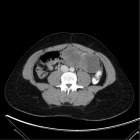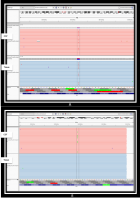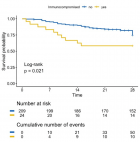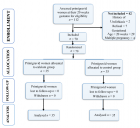About IMSS
IMSS
Articles by IMSS
What is new in Hypertension of Mexico 2018? -Impact of the new classification of high blood pressure in adults from American College of Cardiology/American Heart Association (ACC/AHA)
Published on: 7th March, 2018
OCLC Number/Unique Identifier: 7379463999
The new report of American College of Cardiology/American Heart Association task force on Clinical Practice Guidelines for High Blood Pressure in Adults was published online ahead of print November 13, 2017. The new American recommendation was focused on the criteria to define Hypertension. 130/80 mmHg or more is now considered as the new cut off point to define Hypertension. It is not new if we consider cumulative evidence in the las two decades has been broken the idea to consider 140/90 mmHg as the point to start medical actions. Thus, in México with current ACC/AHA definition it is estimated today around 48 million of adult hypertensive population. In the Mexican Institute of Social Security (IMSS) several strategies has been developed to improve prevention as the key action to confront non communicable chronic disease including hypertension. This updated guideline from ACC/AHA is an extraordinary opportunity to reinforce our preventive programs to high blood pressure control. In this brief report we analyze the epidemiological situation in Mexico and its possible consequences of the new criteria for hypertension diagnosis. The main current strategies that are applied into the IMSS to confront cardiovascular risk factors are directed to prevention. The IMSS is prepared to attend situations as the change of criteria diagnoses in Hypertension and new preventive models are in progression.
Cardiovascular risk reduction: Past, present and future in Mexico
Published on: 17th July, 2018
OCLC Number/Unique Identifier: 7815004265
Atherosclerotic cardiovascular disease (ASCVD) is globally defined as coronary heart disease, cerebrovascular disease, or peripheral arterial disease presumed to be of atherosclerotic origin and it is the leading cause of morbidity and mortality for individuals with or without diabetes and is the largest contributor to the direct and indirect catastrophic costs of cardiovascular disorder. Very common conditions coexisting into the cardiovascular risk (e.g., obesity, hypertension, diabetes and dyslipidemia) are clear risk factors for ASCVD, and diabetes itself confers independent risk. Numerous studies have shown the efficacy of controlling individual cardiovascular risk factors in preventing or slowing ASCVD in people with these disorders. In other words it is not enough control one risk factor. We need to develop novel strategies to detect and control all of them at the same time. Thus, large benefits are seen when multiple cardiovascular risk factors are addressed simultaneously. Under the current paradigm of aggressive risk factor modification in patients with cardiovascular risk, there is evidence that measures of 10-year coronary heart disease (CHD) risk among U.S. adults with cardiovascular risk have improved significantly over the past decade and that ASCVD morbidity and mortality have decreased. In Mexico the Mexican Institute of Social Security is implementing new strategies of primary and secondary prevention in order to confront this pandemic.
In this review, we analyze the state of the art to approach at the same time the different cardiovascular risk factors, in an integral form because of this is the real worldwide challenge of health.
Heart Failure with preserved Ejection Fraction (HFpEF); A Mexican cohort from Mexican Institute of Social Security (IMSS)
Published on: 28th January, 2019
OCLC Number/Unique Identifier: 7991667293
Background: Several epidemiologic studies indicate that up to 50% of patients with heart failure have a preserved ejection fraction, and this proportion has increased over time. The knowledge of its severity and associated comorbidity is determining factor to develop adequate strategies for its treatment and prevention. This study was focus on the creation of a cohort and follow-up of Mexican population and to analyze its severity as well as its interaction with the comorbidity of other cardiovascular risk factors.
Methods: We included patients from different sites of Mexico City than were sent to the Cardiology hospital of the National Medical Center in Mexico City for the realization of an echocardiogram as part of their assessment by the presence of dyspnea, edema, or suspicion of hypertensive heart disease. Complete medical history, physical examination and laboratory studies including Brain Natriuretic Peptide (BNP) serum levels were performed. Diagnosis of diastolic dysfunction was based on symptoms and echocardiographic data including time of deceleration, size of left atrium, e´ septal and e´ lateral, as well as E wave, A wave and its ratio E/A. All patients had left ventricle ejection fraction > 45%.
Results: We included 168 patients with HFpEF. The most common risk factor was hypertension (89.2%), followed by overweight and obesity (> 78.5%), dyslipidemia (82.1%) and diabetes (42.8%). Women were dominant, 108 (64.3%); the mean age was 63 years old. When we classify by severity of diastolic dysfunction, we found that 41.1% were grade I, 57.1% were grade II and only 1.8% were grade III. The risk factors most strongly associated with the severity of diastolic dysfunction were hypertension, obesity and dyslipidemia. We found BNP levels highly variables, but the levels were higher detected as the ejection fraction was approaching to 45%. At one year of follow up mortality was not reported.
Conclusion: HFpEF is a frequent entity in patients with cardiovascular risk factors in Mexico. The most common risk factor was hypertension. The combination of hypertension, overweight and dyslipidemia predicted the severity of diastolic dysfunction. We recommend that all Mexican patient with hypertension and overweight or obesity should be submitted as a part of its medical evaluation to an echocardiogram study in order to detect diastolic dysfunction even though the signs or symptoms are or not evident.

HSPI: We're glad you're here. Please click "create a new Query" if you are a new visitor to our website and need further information from us.
If you are already a member of our network and need to keep track of any developments regarding a question you have already submitted, click "take me to my Query."
















































































































































